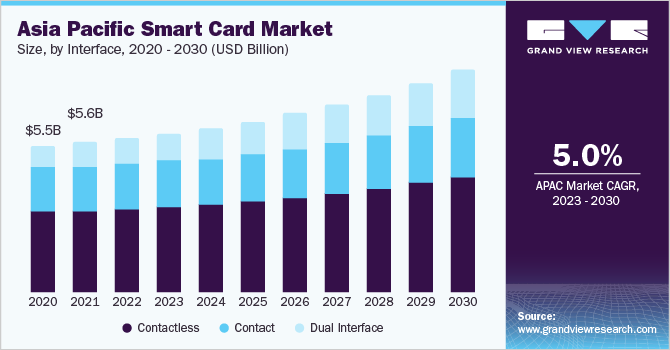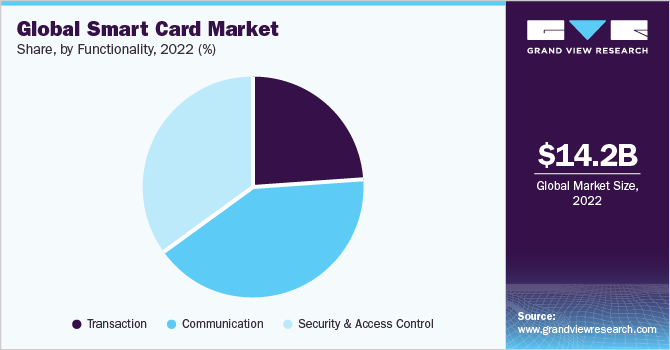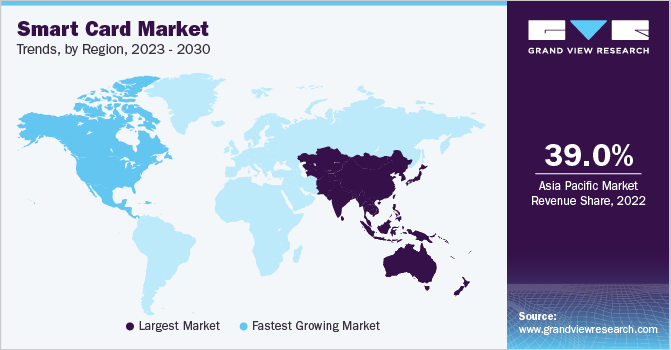- Home
- »
- Next Generation Technologies
- »
-
Smart Card Market Size, Share And Growth Report, 2030GVR Report cover
![Smart Card Market Size, Share & Trends Report]()
Smart Card Market Size, Share & Trends Analysis Report By Interface (Contactless, Dual Interface), By Application (Telecommunication, BFSI), By Functionality (Communication, Transaction), By Type, By Region, And Segment Forecasts, 2023 - 2030
- Report ID: GVR-1-68038-464-2
- Number of Report Pages: 100
- Format: PDF, Horizon Databook
- Historical Range: 2017 - 2021
- Forecast Period: 2023 - 2030
- Industry: Technology
Report Overview
The global smart card market size was estimated at USD 14.23 billion in 2022 and is expected to grow at a compound annual growth rate (CAGR) of 5.7% from 2023 to 2030. A smart card is a tangible card that houses embedded memory or a microcontroller within a contact pad. It establishes a connection with a reader via short-range wireless technologies or direct physical contact methods like radio-frequency identification (RFID) or near-field communication (NFC). Smart cards use encryption to provide safety for in-memory information and are generally developed to be tamper-resistant. Those equipped with a microcontroller chip can perform on-card processing tasks and manage data stored in the chip's memory.

The global market is anticipated to grow significantly over the forecast period. The expansion is fueled by multiple factors, including an upsurge in cashless transactions, rapid digitalization, and increased demand across diverse industry verticals, all of which collectively propel the advancement of the market. Moreover, the emergence of a novel information security paradigm for users, made possible by blockchain technology, is poised to unlock new avenues for the market growth. Smart cards' adept handling of cryptographic keys facilitates secure and seamless transactions within blockchain applications.
Increasing demand for payment systems that offer both security and convenience, coupled with the rising necessity for robust identification and authentication methods, are the major factors influencing the growth of the global market. Smart cards play a key role in serving as effective tools for access control, secure login procedures, and digital signatures, all of which are extensively utilized for identification and authentication. As various industries increasingly require stringent identity verification measures, the demand for smart cards is projected to grow significantly.
Type Insights
The MPU microprocessor segment led the market in 2022, accounting for over 59% share of the global revenue. The MPU microprocessor provides higher processing power, allowing the smart card to execute more sophisticated applications and perform complex computations. Smart cards with MPU microprocessors enhance their functionality, security, and versatility, enabling them to handle more complex tasks and applications than traditional smart cards with simpler microcontrollers. Furthermore, as contactless payments gain popularity, smart cards must support near-field communication (NFC) technology. MPUs can integrate NFC capabilities to facilitate secure and convenient contactless transactions.
The memory segment is estimated to grow significantly over the forecast period. This high growth is attributed to the increasing demand for secure data storage, the proliferation of contactless payment systems, and the widespread adoption of smart cards for various identification and authentication applications. Memory-based smart cards offer efficient and secure storage solutions for sensitive information, making them a preferred choice for enterprises and sectors requiring reliable data management and protection. These cards are often used in high-volume applications where the primary requirement is data storage and retrieval, such as transportation cards, loyalty cards, and basic access control cards.
Interface Insights
The contactless segment led the market in 2022, accounting for over 53% share of the global revenue. A contactless smart card incorporates an embedded secure microcontroller or similar intelligence, internal memory, and a small antenna. It communicates with readers through a radio frequency (RF) interface without physical contact. Communication technologies like radio-frequency identification (RFID) or near-field communication (NFC) are predominantly utilized for contactless smart card applications. Notably, the growth of the contactless smart card industry has been positively influenced by the COVID-19 pandemic. The World Health Organization (WHO) and governments globally endorsed the use of contactless smart cards for various purposes to uphold social distancing measures and mitigate the spread of the virus. Contactless smart cards offer users convenience, swiftness, and ease of use.
The dual interface segment is estimated to grow significantly over the forecast period due to its ability to combine contact and contactless functionalities within a single, smart card. Dual interface smart cards offer versatility and compatibility, enabling users to leverage both contact-based and contactless communication methods. This adaptability has garnered significant interest from various enterprises and sectors, driving the segment's growth in the market. For instance, in February 2021, ICICI Bank Limited collaborated with Chennai Smart City Limited (CSCL) and the Greater Chennai Corporation (GCC) to introduce the Namma Chennai smart card. This prepaid card enables seamless retail transactions within Chennai and extends its functionality to encompass retail outlets and online shopping platforms across the nation.
Application Insights
The telecommunication segment held the largest revenue share of over 40% in 2022. Smart cards have extensive use in the telecommunications industry, particularly in the form of SIM (Subscriber Identity Module) cards for mobile phones. These cards serve as a critical component for enabling secure communication, authenticating subscribers, managing mobile network access, and providing a platform for value-added services. As mobile networks evolve to support advanced technologies like 5G, the role of smart cards in ensuring secure and efficient communication is likely to become even more crucial. In addition, integrating mobile services beyond traditional communication, such as mobile payments and digital identity, reinforces the positive trajectory of smart card applications in the telecom industry.
The BFSI segment is predicted to foresee significant growth in the forecast period. The adoption of smart cards within the banking, financial services, and insurance (BFSI) sector offers numerous benefits, notably ensuring the safety of data transfers and protecting confidential information. Smart cards are also used as access control cards, payment authentication cards, and debit or credit cards in the BFSI industry. These versatile cards also serve as electronic wallets when funds are loaded onto them, enabling secure money transfers through cryptographic protocols to vending machines or accounts.
Functionality Insights
The communication segment held the largest revenue share of over 40% in 2022. Smart cards with communication functionalities, such as near-field communication (NFC) and contactless payment capabilities, have gained significant popularity due to the growing need for seamless and convenient connectivity. These features enable users to make secure payments, access data, and interact with various devices without physical contact. The expansion of the Internet of Things (IoT) and smart devices has also driven the demand for communication-enabled smart cards. These cards can authenticate users, transfer data, and establish secure connections between devices, donating to the segment's growth.

The transaction segment is predicted to foresee significant growth in the forecast period, driven by the increasing use of smart cards across various transactions. These cards serve as payment cards (credit, debit, prepaid), offering enhanced security and expanded data storage compared to magnetic stripe cards. They're also vital for access control, ensuring security in buildings, offices, and transportation. In addition, smart cards play a role in loyalty programs, enabling businesses to monitor spending and reward loyal patrons while serving as efficient and secure transport tickets for buses, trains, and metros.
Regional Insights
Asia Pacific dominated the market in 2022, accounting for over 39% share of the global revenue. Governments and businesses in the Asia Pacific are increasingly recognizing the advantages of smart cards in enhancing data security, streamlining processes, and improving customer experiences. In addition, the rise of mobile technology and the Internet of Things (IoT) is driving the integration of smart card capabilities into various devices, further boosting the market's growth. For instance, in January 2023, Delhi Metro Rail Corporation Limited partnered with Airtel Payments Bank Ltd., an Indian payments bank, to offer commuters smart card top-up service. This collaboration aims to bring digital transaction services to a wider audience and enhance the convenience of public transportation in Delhi.

North America is anticipated to register the fastest CAGR over the forecast period. With the rise of digitalization and the integration of smart card technology across industries, the North American market is witnessing expansion across sectors like finance, healthcare, government, and more. Government policymakers in the region are closely examining strategies to enhance the efficiency of information systems within the healthcare industry. A significant focus has been placed on the widespread adoption of electronic health records for all citizens and the establishment of seamless record exchange mechanisms at all operational levels.
Key Companies & Market Share Insights
Prominent firms have used product launches and developments, followed by expansions, mergers and acquisitions, contracts, agreements, partnerships, and collaborations as their primary business strategy to increase their market share. The companies have used various techniques to enhance market penetration and boost their position in the competitive industry. For instance, in May 2023, IDEX Biometrics ASA and AuthenTrend Technology Inc. partnered to introduce multi-application biometric smart cards for digital authentication. This innovative card is tailored to address identity access and secure cryptocurrency wallets. These biometric cards are poised to reshape the authentication landscape by providing customers with swifter, more robust, and more convenient ways to authenticate their transactions. Some of the prominent players in the global smart card market include:
-
Block, Inc.
-
CardLogix Corporation
-
CPI Card Group Inc.
-
Giesecke+Devrient GmbH
-
HID Global Corporation
-
IDEMIA
-
INTELIGENSA
-
Samsung Electronics Co., Ltd.
-
Sony Corporation
-
Thales
Smart Card Market Report Scope
Report Attribute
Details
Market size value in 2023
USD 14.77 billion
Revenue forecast in 2030
USD 21.73 billion
Growth rate
CAGR of 5.7% from 2023 to 2030
Base year for estimation
2022
Historical data
2017 - 2021
Forecast period
2023 - 2030
Quantitative units
Revenue in USD million/billion and CAGR from 2023 to 2030
Report coverage
Revenue forecast, company ranking, competitive landscape, growth factors, and trends
Segments covered
Type, interface, functionality, application, region
Regional scope
North America; Europe; Asia Pacific; Latin America; MEA
Country scope
U.S.; Canada; UK; Germany; France; China; Japan; India; South Korea; Australia; Brazil; Mexico; Kingdom of Saudi Arabia (KSA); UAE; South Africa
Key companies profiled
Block, Inc.; CardLogix Corp.; CPI Card Group Inc.; Giesecke+Devrient GmbH; HID Global Corp.; IDEMIA; INTELIGENSA; Samsung Electronics Co., Ltd.; Sony Corp.; Thales
Customization scope
Free report customization (equivalent up to 8 analysts working days) with purchase. Addition or alteration to country, regional & segment scope.
Pricing and purchase options
Avail customized purchase options to meet your exact research needs. Explore purchase options
Global Smart Card Market Report Segmentation
This report forecasts revenue growth at global, regional, and country levels and provides an analysis of the latest trends in each of the sub-segments from 2017 to 2030. For this study, Grand View Research has segmented the global smart card market report based on type, interface, functionality, application, and region.
-
Type Outlook (Revenue, USD Billion, 2017 - 2030)
-
Memory
-
MPU Microprocessor
-
-
Interface Outlook (Revenue, USD Billion, 2017 - 2030)
-
Contact
-
Contactless
-
Dual Interface
-
-
Functionality Outlook (Revenue, USD Billion, 2017 - 2030)
-
Transaction
-
Communication
-
Security & Access Control
-
-
Application Outlook (Revenue, USD Billion, 2017 - 2030)
-
BFSI
-
Telecommunication
-
Government & Healthcare
-
Retail & E-commerce
-
Transportation
-
Others
-
-
Regional Outlook (Revenue, USD Billion, 2017 - 2030)
-
North America
-
U.S.
-
Canada
-
-
Europe
-
Germany
-
UK
-
France
-
-
Asia Pacific
-
China
-
Japan
-
India
-
South Korea
-
Australia
-
-
Latin America
-
Brazil
-
Mexico
-
-
Middle East and Africa (MEA)
-
Kingdom of Saudi Arabia
-
UAE
-
South Africa
-
-
Frequently Asked Questions About This Report
b. The global smart card market size was estimated at USD 14.23 billion in 2022 and is expected to reach USD 14.77 billion in 2023.
b. Key factors that are driving the smart card market growth include upsurge in cashless transactions and increasing demand for payment systems.
b. The global smart card market is expected to grow at a compound annual growth rate of 5.7% from 2023 to 2030 to reach USD 21.73 billion by 2030.
b. Asia Pacific dominated the smart card market with a share of 40.1% in 2022. Governments and businesses in the Asia Pacific are increasingly recognizing the advantages of smart cards in enhancing data security, streamlining processes, and improving customer experiences.
b. Some key players operating in the smart card market include Block, Inc.; CardLogix Corporation; CPI Card Group Inc.; Giesecke+Devrient GmbH; HID Global Corporation; IDEMIA; INTELIGENSA; Samsung Electronics Co., Ltd.; Sony Corporation; Thales.
Share this report with your colleague or friend.
![gvr icn]()
NEED A CUSTOM REPORT?
We can customize every report - free of charge - including purchasing stand-alone sections or country-level reports, as well as offer affordable discounts for start-ups & universities. Contact us now
![Certified Icon]()
We are GDPR and CCPA compliant! Your transaction & personal information is safe and secure. For more details, please read our privacy policy.
We are committed towards customer satisfaction, and quality service.
"The quality of research they have done for us has been excellent."





